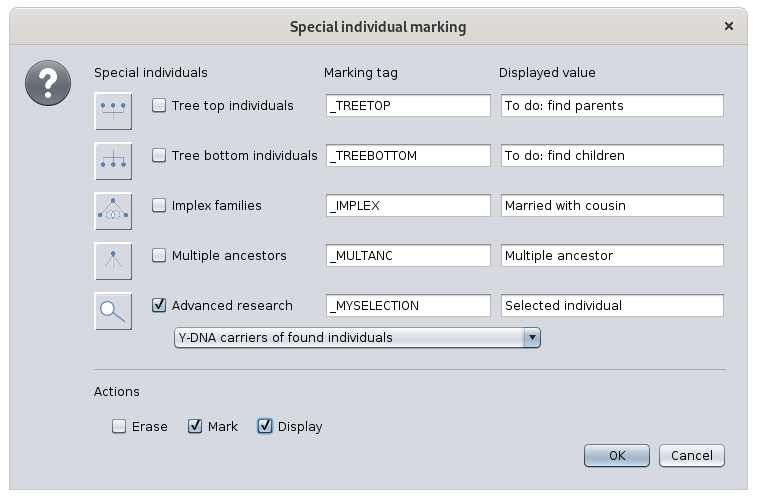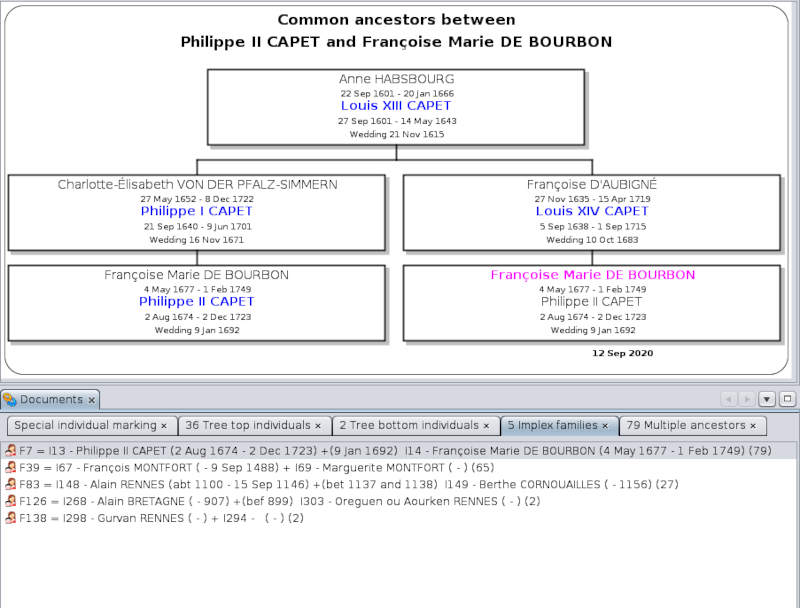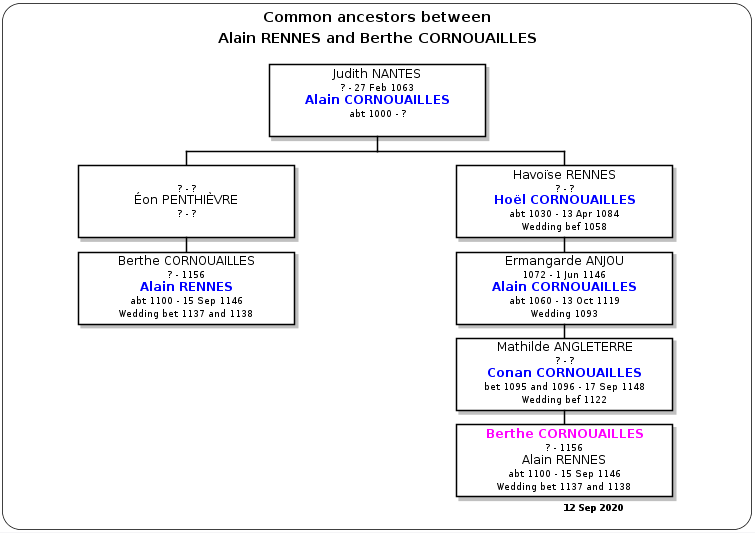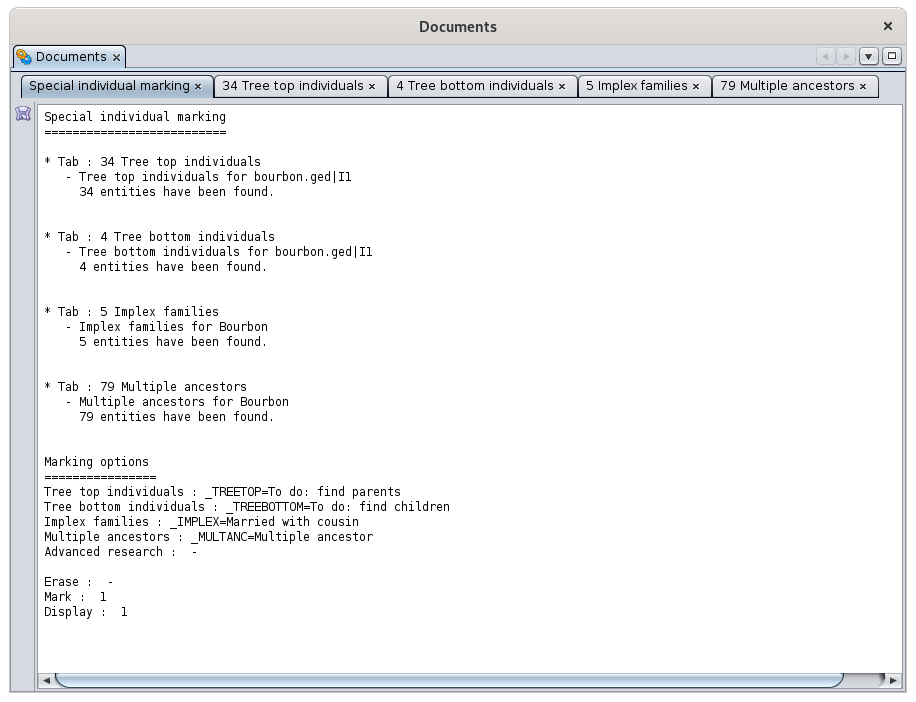Mark special individuals (L)
This feature marks or displays certain special individuals in your genealogy such as implex families, tree top individuals, Y-DNA related people, etc.
Description
At Ancestris, we have identified several types of populations in your genealogy that might be of great interest to you. They are listed in this window and described below.
- Tree top individuals: these are the individuals without parents at the top of the ascending tree of a given root individual taken as De Cujus.
- Tree bottom individuals: conversely, these are the individuals without children at the base of the tree descending from a root individual taken as a starting point. They can be single or married, and they do not have recorded descendant.
- Implex families: these are "couples of cousins", i.e. individuals forming a union and having at least one common ancestor. Their union generates the implex, that is to say a reduction in the number of ancestors of their descendants. They may or may not already have children identified in the genealogy.
- Multiple ancestors: these are the individuals who have implex families among their descendants. Each multiple ancestor can be a multiple ancestor of different couples.
- Advanced research: these are the individuals found and resulting from the Advanced search, or persons relating to them in a certain way. Hence we can choose to mark:
- the found individuals themselves
- the parents of the found individuals
- the children of the found individuals
- the spouses of the found individuals
- the ancestors of the found individuals
- the descendants of the found individuals
- the carriers of the Y-DNA of the found individuals
- the carriers of the mt-DNA of the found individuals
For each of these populations, Ancestris lets you define a user-defined tag to mark them and find them more easily later, for example in the Advanced search view itself. You can name the tag as you like. Ancestris will make sure it starts with the '_' character.
Ancestris also lets you define the value for that tag. The screen above suggests possible tags and values.
Finally, the check boxes at the bottom of the window let you choose whether to erase, mark, or display only the corresponding individuals.
Once the individuals are marked, you can see the tags in the Gedcom editor.
Usage
Marking individuals can be very useful to easily locate individuals and doing some analysis.
The tree top individuals and the tree bottom individuals represent the outer perimeter of your genealogical progress in terms of individuals.
Implex families and multiple ancestors provide a better understanding of filiations in your genealogy.
As you can see in the screenshotfollowing below,example, Ancestris quickly enlightens you on all the implex couples in your genealogy and on their relationships, thanks to this tool combined with the Common Ancestors tool.
To get there, make sure you have displayed the reference individual in the Ancestris views before launching this tool, check the populations that interest you in the choice window described above and click OK.
The choice of a reference individual is only useful for top and bottom individuals. For implexes and multiple ancestors, Ancestris searches the entire genealogy.
For each of the special populations, Ancestris creates a tab in the Documents window.
TreeTop individuals
In the case of the Bourbon file used here, we asked for the marking and display of the top individuals by displaying before the character of Louis XIII.
Ancestris found 34 top individuals in its ascendant tree. These individuals are displayed in the list. Just click on them to display them in the views of Ancestris.
Each individual name is preceded by a Sosa number generated for the occasion, but not stored in Gedcom. This number is constructed like the other Sosa numbers in Ancestris, that is to say with the generation number and the Sosa number itself.
The list is sorted in ascending order of genealogy and Sosa number.
By clicking on one of the individuals and viewing it in the Gedcom editor, we see that the _TREETOP label has been added.
TreeBottom Individuals
In the case of the Bourbon file used here, we requested the marking and display of individuals at the base by displaying the character of Louis XIII before.
Ancestris found 4 individuals at the base of its descending tree. These individuals are displayed in the list. Just click on them to display them in the views of Ancestris.
Each individual name is preceded by an Aboville number generated for the occasion, but not kept in Gedcom. This number is constructed like the other Ancestris Aboville numbers, that is to say with the generation number and the actual Aboville number.
The list is sorted in ascending order of genealogy and Sosa number.
By clicking on one of the individuals and viewing it in the Gedcom editor, we see that the _TREEBOTTOM tag has been added.
For basic individuals who form at least one family without children, the name of the family is indicated in the value of the tag, and one tag is created for each family without children.
Implex families
In the case of the Bourbon file used here, we requested the marking and display of the implex families. This marking does not require specifying a reference individual.
Ancestris found 5 implex families in the entire Bourbon genealogy provided by Ancestris. These families are displayed in the list. Just click on them to display them in the views of Ancestris.
Each last name is followed by a number in parentheses. This is the number of ancestors common to both members of the couple. Note that these individuals will find themselves Multiple Ancestors in the next tab.
The list is sorted in descending order of the number of common ancestors.
By clicking on one of the families, the Common Ancestors viewing window displays the visual path of one of the common ancestors between the two members of the couple.
In the Gedcom editor, we see that the _IMPLEX tag has been added to the family.
Multiple ancestors
In the case of the Bourbon file used here, we requested the marking and display of multiple ancestors. This marking does not require specifying a reference individual.
Ancestris found 79 multiple ancestors throughout the Bourbon genealogy provided by Ancestris. These individuals are displayed in the list. Just click on them to display them in the views of Ancestris.
Each individual name is followed by a number in parentheses. It is the number of couples among his descendants who are implex families. Note that these families will be found again Implex families in the previous tab.
The list is sorted in descending order of the number of these implex families.
Clicking on one of the individuals displays it in the views of Ancestris. In the Gedcom editor, we see that the _MULTANC tag has been added to the individual, followed by the label and the list of all the implex families of his descendants.
Multiple ancestors can be displayed in black (they are then holders of the _SOSA or _SOSADABOVILLE label resulting from a previous numbering), or displayed in purple (no link with the ascending or descending lines of the De Cujus.
Advanced search
In the case of the Bourbon file used here, we asked for the marking of the parents of individuals of profession Abbess.
In the Advanced Search, we have already selected the Abbesses. Then in the marking tool, we checked Advanced Search, then chose the relation "Parents of individuals found".
Ancestris found 6 abbesses, and 11 relatives.
The individuals are sorted in alphabetical order.
Clicking on one of the individuals displays it in the views of Ancestris. In the Gedcom editor, we see that the _MYSELECTION label has been added to the individual, followed by the label defined in the choice of markings window.
Special indivudal marking tab
In order for you to know the marking request you did, the first tab generated is a summary of your request and the list of results.
Customization
There is no specific customization for this tool.















